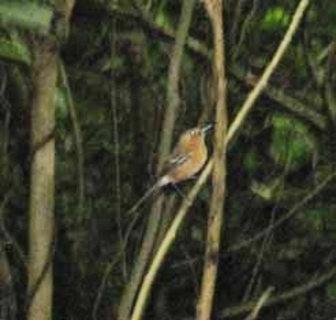Tinian monarch
It is threatened by habitat loss. The Tinian Monarch has been delisted as endangered by the United States Fish and Wildlife Services, see the Draft Post-Delisting Monitoring Plan. The current population of Tinian Monarchs is estimated to be over 52,900 individuals.

The Tinian monarch is classified as Vulnerable (VU), considered to be facing a high risk of extinction in the wild.
The Tinian Monarch (Monarcha takatsukasae) is a species of bird in the Monarchidae family. It is endemic to Northern Mariana Islands, and found only on the island of Tinian. Its natural habitats are subtropical or tropical moist lowland forests and subtropical or tropical moist shrubland. It is threatened by habitat loss. The Tinian Monarch has been delisted as endangered by the United States Fish and Wildlife Services, see the Draft Post-Delisting Monitoring Plan. More
Surveys conducted in 1982 estimated the Tinian monarch population at 39,338 . This prompted the downlisitng of the monarch to threatened in 1987 . In 1994 and 1995 the population was estimated at 52,900 and in 1996, a replication of the 1982 surveys produced an estimate of 55,720 . The 1996 survey also found that forest density had increased indicating that the quality of the monarch’s habitat had improved as well . In 1999 the U.S. More
Tinian Monarch flycatcher from the list of threatened and endangered species. Federal Register November 1, 1985 (50 FR 45632-45633]. More
* States/US Territories in which the Tinian Monarch is known to occur: Northern Mariana Islands * US Counties in which the Tinian Monarch is known to occur: View All More
proposed today to remove the Tinian monarch, a small flycatcher found only on the island of Tinian in the Commonwealth of the Northern Mariana Islands (CNMI) in the western Pacific, from the list of threatened and endangered species. If the proposal is finalized, this will be the fourth Pacific bird species removed from the protection of the Endangered Species Act due to its recovery. More
The Tinian monarch is a small (6-inch or 16-centimeter) flycatcher with light rufous underparts, olive-brown upperparts, dark brown wings and tail, and white rump and undertail coverts. It feeds primarily on insects. Current population estimates indicate approximately 57,000 Tinian monarchs exist on Tinian. They forage and breed throughout the entire island both in nonnative tangentangen and in native limestone forests. However, they live and reproduce in much higher numbers in the native forest. More
Monitoring plan for Tinian monarch up for review A draft plan for the continued monitoring of the Tinian monarch-a forest bird endemic to the island of Tinian-was released yesterday for public review and comment. This detailed plan, required by the Endangered Species Act, provides guidance to monitor the status of the species for no fewer than five years. More
of the Tinian monarch, regular field surveys for the brown treesnake (Boiga irregularis) on Tinian, and tracking of land use and development on Tinian. ADDRESSES: Copies of the Monitoring Plan are available by request from the Hawaiian Bird Recovery Coordinator, U.S. Fish and Wildlife Service, Pacific Islands Fish and Wildlife Office, 300 Ala Moana Blvd., Box 50088, Honolulu, Hawaii 96850 (telephone: 808-792-9400; fax: 808-792- 9580). More
Remove the Tinian Monarch From the Federal List of Endangered and Threatened Wildlife AGENCY: Fish and Wildlife Service, Interior. ACTION: Final rule. - SUMMARY: Under the authority of the Endangered Species Act (Act) of 1973, as amended (16 U.S.C. 1531 et seq), we, the U.S. Fish and Wildlife Service, remove the Tinian monarch (Monarcha takatsukasae) from the Federal List of Endangered and Threatened Wildlife. More
I am fairly certain they are Tinian Monarch young, since this was the most common bird that we saw on the hike. I did see one or two Rufous Fantails, but we saw many many more Monarchs. We travelled from one kamachili tree to an ironwood tree to another tree, and not finding much. I finally got tried and decided to head west towards 8th Avenue. As we walked towards 8th Avenue, we found more kamachili and ironwood trees. More
The Tinian monarch adapted well to shrubby vegetation seeded following WWII and after its population reached 39,338 in 1982, the monarch was proposed for downlisting; a continued increase led to the species’ delisting in 1999. MP(b) - Palau fantail flycatcher Rhipidura lepida The Palau fantail flycatcher was virtually eliminated by damage caused during World War II. More
The Tinian monarch (Monarcha takatsukasae) is a small brownish song bird that is endemic to the island of Tinian, north of Guam in the Mariana Archipelago. Deforestation, first for sugarcane production, and later as a result of World War II combat activities, caused a severe depletion of the monarch population. The FWS listed the Tinian monarch as endangered in 1970 under the ESCA (35 FR 8495) based on pre- and post-war data. More
Family : Monarchidae
Genus : Monarcha
Species : takatsukasae
Authority : (Yamashina, 1931)

